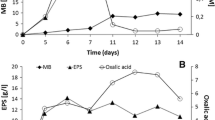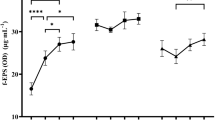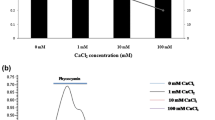Abstract
Production of an exopolysaccharide (glucan) by Acremonium diospyri was not markedly affected by its specific growth rate, the culture pH or the stirrer speed under NH +4 -limiting chemostat conditions. The exopolysaccharide was also detected in the medium under conditions of NH +4 excess.
Similar content being viewed by others
References
Buchala, A.J. & Leisola, M. 1987 Structure of the β-glucan secreted by Phanaerochaete chrysosporium in continuous culture. Carbohydrate Research 165, 146–149.
Bull, A.T. & Trinci, A.P.J. 1977 The physiology and metabolic control of fungal growth. Advances in Microbial Physiology 15, 1–84.
Bulmer, M.A., Catley, B.J. & Kelly, P.J. 1987 The effect of ammonium ions and pH on the elaboration of the fungal extracellular polysaccharide, pullulan, by Aureobasidium pullulans. Applied Microbiology and Biotechnology 25, 262–265.
Catley, B.J. 1971 Role of pH and nitrogen limitation in the elaboration of the extracellular polysaccharide pullulan by Pullularia pullulans. Applied Microbiology 22, 650–654.
Dubois, M., Gillies, K.A., Hamilton, J.K., Rebers, P.A. & Smith, F. 1956 Colorimetric method for the determination of sugars. Analytical Chemistry 28, 350–356.
McNeil, B., Kristiansen, B. & Seviour, R.J. 1989 Polysaccharide production and morphology of Aureobasidium pullulans in continuous culture. Biotechnology and Bioengineering 33, 1210–1212.
Pitt, D.E. & Bull, A.T. 1982 The adenine nucleotide composition of growing and stressed cultures of Trichoderma aureoviride. Experimental Mycology 6, 41–51.
Rau, U., Gura, E., Olszewski, E. & Wagner, F. 1992 Enhanced glucan formation of filamentous fungi by effective mixing, oxygen limitation and fed-batch processing Journal of Industrial Microbiology, 9, 19–26.
Rowley, B.I. & Bull, A.T. 1973 Chemostat for the cultivation of moulds. Laboratory Practice 286–289.
Seviour, R.J. & Hensgen, K. 1983 Exocellular glucan production by Acremonium diospyri. FEMS Microbiology Letters 16 343–346.
Seviour, R.J. & Kristiansen, B. 1983 Effect of ammonium ion concentration on polysaccharide production by Aureobasidium pullulans. European Journal of Applied Microbiology and Biotechnology 17, 178–181.
Seviour, R.J., Kristiansen, B. & Harvey, L. 1984 Morphology of Aureobasidium pullulans during polysaccharide elaboration. Transactions of the British Mycological Society 82, 350–356.
Seviour, R.J., Stasinopoulos, S.J., Auer, D.P.F. & Gibbs, P.A. 1992 Production of pullulan and other exopolysaccharides by filamentous fungi. Critical Reviews in Biotechnology 12, 279–298.
Stasinopoulos, S.J. & Seviour, R.J. 1990 Exopolysaccharide formation by isolates of Cephalosporium and Acremonium. Mycological Research 92, 55–60.
Stasinopoulos, S.J. & Seviour, R.J. 1992 Exopolysaccharide production by Acremonium persicinum in stirred-tank and air-lift fermentors. Applied Microbiology and Biotechnology 36, 465–468.
Additional information
P. Wood and R.J. Seviour are with the Biotechnology Research Centre, La Trobe University College of Northern Victoria, Bendigo, Victoria 3550, Australia
Rights and permissions
About this article
Cite this article
Wood, P., Seviour, R.J. Exopolysaccharide production by Acremonium diospyri in continuous culture. World Journal of Microbiology & Biotechnology 10, 14–16 (1994). https://doi.org/10.1007/BF00357554
Revised:
Accepted:
Issue Date:
DOI: https://doi.org/10.1007/BF00357554




